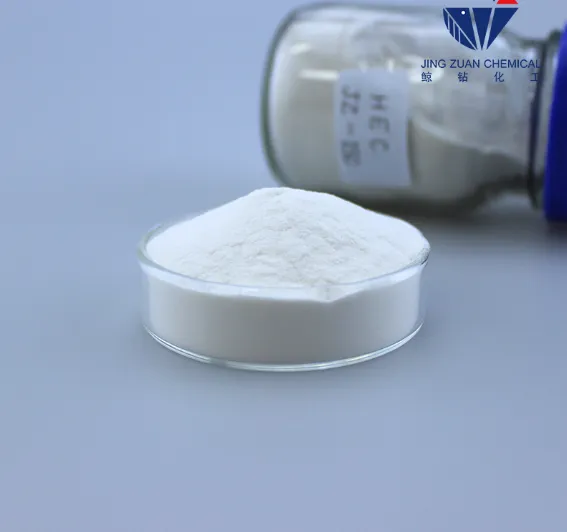
Mei . 16, 2025 17:41 Kembali kepada senarai
The Main Applications of Hydroxyethyl Cellulose in Paints and Coatings
Hydroxyethyl Cellulose is a non-ionic cellulose ether with good water solubility, thickening, suspension, dispersion, film-forming, and water retention properties. Due to its unique physical and chemical properties, Hydroxyethyl Cellulose is widely used in multiple fields, among which the paint and coating industry is undoubtedly one of its most important applications. The application of Hydroxyethyl Cellulose in paints and coatings significantly improves product performance, enhances construction efficiency, and meets the growing market demand.

Hydroxyethyl Cellulose plays a crucial thickening role in paints and coatings
By increasing the viscosity of the system, HEC cellulose can effectively prevent the settling of pigments and fillers, maintain the uniform dispersion of the coating, and ensure the consistency and saturation of the coating color. Especially in water-based coatings, Hydroxyethyl Cellulose can effectively prevent pigment coagulation and precipitation, avoiding color differences and uneven gloss. In addition, the thickening effect of Hydroxyethyl Cellulose also endows the coating with good workability, such as preventing the coating from sagging when using rollers or brushes, ensuring the smoothness and uniformity of the coating.
Hydroxyethyl Cellulose also has good water retention performance
During the drying process of coatings, hec hydroxyethyl cellulose can slow down the evaporation rate of water, prolong the opening time of coatings, and improve the leveling and adhesion of coatings. This is crucial for preventing defects such as cracks and bubbles in the coating during the drying process. Especially under dry climate conditions, the water retention performance of Hydroxyethyl Cellulose can significantly improve the quality of coatings and enhance their durability.
Hydroxyethyl Cellulose also has the functions of dispersion and suspension in coatings
By adsorbing on the surface of pigment particles, methyl hydroxyethyl cellulose can effectively prevent the aggregation of pigment particles and maintain the stable dispersion state of the pigment. This can not only improve the coloring power of the coating, but also enhance the glossiness and weather resistance of the coating. In addition, Hydroxyethyl Cellulose can also serve as a suspension agent to prevent the precipitation of solid components in coatings and maintain their stability.
In summary, hydroxyethylcellulose based materials play an irreplaceable role in the field of paints and coatings due to their excellent thickening, water retention, dispersibility, and suspension properties. It can not only improve the construction performance and stability of coatings, but also enhance the quality and durability of coatings. With the increasing demand for environmental protection, the application of water-based coatings is becoming more and more widespread. Hydroxyethyl Cellulose, as a safe and environmentally friendly thickener, will have a broader application prospect in the fields of paint and coatings. The future research direction may focus on the modification and composite application of Hydroxyethyl Cellulose to further improve its performance and meet more diverse market demands.
Hydroxyethyl Cellulose FAQs
What is the role of Hydroxyethyl Cellulose in paints and coatings?
Hydroxyethyl Cellulose is mainly used as a thickener, rheological modifier, and stabilizer in paints and coatings. It can increase the viscosity of the system, improve construction performance (such as anti splash and anti sagging), and enhance the suspension of pigments to prevent precipitation. In addition, Hydroxyethyl Cellulose can optimize the leveling of the coating, improve the uniformity and glossiness of the final coating.
What are the advantages of Hydroxyethyl Cellulose compared to other cellulose ethers in coatings?
Hydroxyethyl Cellulose exhibits better salt resistance and ion stability in coatings, making it suitable for high electrolyte systems such as latex paint. It has better water solubility, faster dissolution rate, and is insensitive to pH changes (pH 212 is stable). Compared with HPMC, Hydroxyethyl Cellulose has stronger water retention, which can effectively prolong the opening time of coatings and improve construction performance.
What are the precautions for dissolving Hydroxyethyl Cellulose?
Hydroxyethyl Cellulose should be slowly added to cold water while stirring to avoid direct pouring and causing clumping. It can be pre mixed with some non solvents (such as ethylene glycol) to improve dispersibility. It is recommended to use high shear mixing equipment when dissolving, and the temperature should not exceed 60 ℃, otherwise it may affect the viscosity. Complete dissolution usually takes 2030 minutes, depending on the viscosity grade.
How does the viscosity of Hydroxyethyl Cellulose affect the performance of coatings? How to choose the appropriate model?
Hydroxyethyl Cellulose has a wide viscosity range (such as 1% solution viscosity from 100 mPa · s to over 100000 mPa · s). Low viscosity (1001000 mPa · s) is suitable for systems that require high fluidity, such as spray coatings; Medium to high viscosity (300020000 mPa · s) is used for latex paint or putty, balancing thickening and workability; Ultra high viscosity (>50000 mPa · s) is used for high solid content or relief coatings.
What is the application trend of Hydroxyethyl Cellulose in environmentally friendly coatings?
With the increasing demand for water-based coatings, Hydroxyethyl Cellulose has become an important additive for environmentally friendly formulations due to its non-toxic and biodegradable properties. It replaces traditional solvent based thickeners, reduces VOC emissions, and is compatible with low formaldehyde and zero formaldehyde systems. In the future, modified Hydroxyethyl Cellulose (such as hydrophobic or thixotropic) will be more suitable for the development of high-performance green coatings. v
-
Unlocking the Benefits of HPMC Products: A Gateway to Versatile Applications
BeritaAug.07,2025
-
Tile Bonding Cellulose: The Key to Superior Adhesion and Durability
BeritaAug.07,2025
-
Hydroxypropyl Methylcellulose Powder: The Versatile Component in Modern Pharmaceuticals
BeritaAug.07,2025
-
Hydroxyethyl Cellulose: The Versatile Solution for Various Industries
BeritaAug.07,2025
-
Hydroxyethyl Cellulose (HEC): The Versatile Polymer for Various Applications
BeritaAug.07,2025
-
The Ultimate Guide to Mortar Bonding Agent
BeritaAug.06,2025







